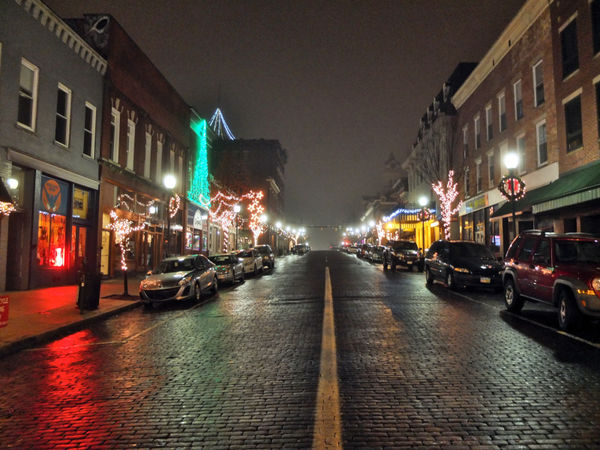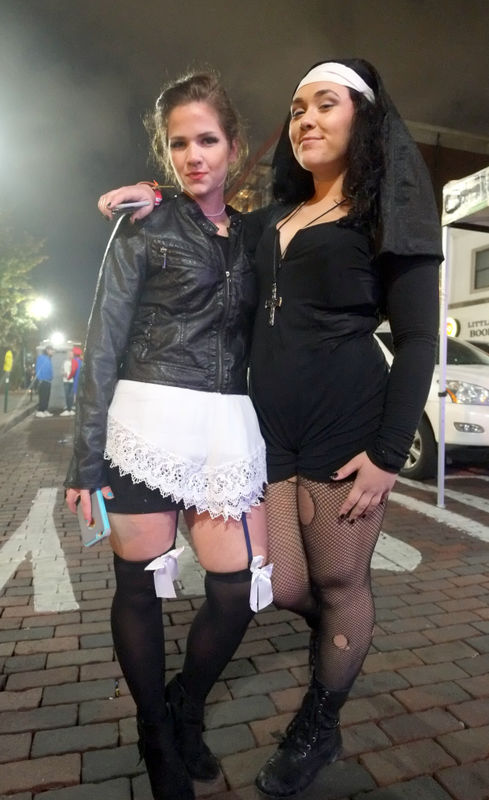City night shots
May 12, 2019 16:43:13 #
I have a Canon SX10, a crossover camera, and would like to know what are the best settings for night photography, especially cities. I have used a night setting, with sometimes good results, and sometimes not...not good as you sometimes don't get a second chance. Appreciate any help, at all. Buzzard 19937
May 12, 2019 17:02:10 #
Old Timer
Loc: Greenfield, In.
I still have my sx10, my first camera that had some control over. I had always used point and shoot so there was a learning curve for awhile. It is basically the same settings that you would use in other camera. I go back and look as some of my pics and there were some good shots. I learned how to use av and tv settings some manual and night shooting. It was a good camera to learn the basics on. I used it for about two years before getting my first dslr. They controls a not quiet as intuitive as the dslr but if you practice and read your manual you can have some good results. I can not tell you the settings, that is something your have to learn through study and practice.
May 12, 2019 17:19:13 #
Do you have a copy of the user manual? It can be found here:
http://gdlp01.c-wss.com/gds/7/0300001567/01/PSSX10IS_CUG_EN.pdf
In reading the purpose of both night snapshot and night scene, those seem more for posed shots in specific situations. It could be that the disappointing photos you speak of were less well lighted and needed a slower shutter speed. That can cause blur from your own motion. Or the camera metered (set its exposure) on a brighter area, when you wanted more detail in the shadows.
These and other instances all speak to the need to understand how the camera sets exposure and how each "special" mode works. For a start, try shutter priority, do controlled tests and then check the results. These controlled tests should include taking the same composition at different focal lengths (zoom), different shutter speeds and in different lighting.
I mention shutter priority instead of aperture priority because your camera, even more so than many newer bridge cameras, has a very narrow range of aperture (f/stop) settings. And you will achieve more depth of field (what's in focus from front to rear) from these cameras than a dslr anyway, so any advice should take the camera's construction into consideration.
http://gdlp01.c-wss.com/gds/7/0300001567/01/PSSX10IS_CUG_EN.pdf
In reading the purpose of both night snapshot and night scene, those seem more for posed shots in specific situations. It could be that the disappointing photos you speak of were less well lighted and needed a slower shutter speed. That can cause blur from your own motion. Or the camera metered (set its exposure) on a brighter area, when you wanted more detail in the shadows.
These and other instances all speak to the need to understand how the camera sets exposure and how each "special" mode works. For a start, try shutter priority, do controlled tests and then check the results. These controlled tests should include taking the same composition at different focal lengths (zoom), different shutter speeds and in different lighting.
I mention shutter priority instead of aperture priority because your camera, even more so than many newer bridge cameras, has a very narrow range of aperture (f/stop) settings. And you will achieve more depth of field (what's in focus from front to rear) from these cameras than a dslr anyway, so any advice should take the camera's construction into consideration.
May 13, 2019 10:40:26 #
A good way to get comfortable shooting urban scenes at night is to put your camera in program mode, auto ISO, and shoot away. Then you can adjust your settings based on the results and your EXIF data. Here are some examples, shot with a D7100: http://www.ipernity.com/doc/depscribe/album/745504
Also, this, taken on a rainy Christmas Eve with a Fuji X10, program, auto ISO:
Also, this, taken on a rainy Christmas Eve with a Fuji X10, program, auto ISO:

May 13, 2019 10:51:28 #
If the scene is like the picture in the post above then use a tripod. Use manual mode. Use lowest ISO. Set the aperture to get sufficient depth of field to get all of your important subjects in focus. Use the meter to set the shutter speed. Take a test shot. The first one would generally be too bright. Shorten the shutter speed a bit and take another shot until you have good image.
May 13, 2019 11:03:29 #
BebuLamar wrote:
If the scene is like the picture in the post above then use a tripod. Use manual mode. Use lowest ISO. Set the aperture to get sufficient depth of field to get all of your important subjects in focus. Use the meter to set the shutter speed. Take a test shot. The first one would generally be too bright. Shorten the shutter speed a bit and take another shot until you have good image.
I shot the picture handheld, 1/15 f2 ISO 800. No tripod. No problem. Shutter speed, aperture, ISO all set by camera.
May 13, 2019 11:07:08 #
depscribe wrote:
I shot the picture handheld, 1/15 f2 ISO 800. No tripod. No problem.
I knew that but I would use the tripod as there is no moving subjects in your shot. Using the tripod I can have more DOF which I think would make such an image better and also I can use lower ISO which also gives me better image. Doing so would also compensate for the OP camera which has smaller sensor and would benefit from a lower ISO.
May 13, 2019 11:20:11 #
BebuLamar wrote:
I knew that but I would use the tripod as there is no moving subjects in your shot. Using the tripod I can have more DOF which I think would make such an image better and also I can use lower ISO which also gives me better image. Doing so would also compensate for the OP camera which has smaller sensor and would benefit from a lower ISO.
Sometimes -- usually -- it comes down to whether you want a picture or not. Carting a tripod around, or proposing that a tripod is necessary, runs counter most of the time to the idea of getting a picture. Here's a no-flash picture from the annual city/college nighttime Halloween party, which I've covered for years, hand-held always, no flash ever (well, late in the evening some of the participants were wont to flash, but that's a non-photographic issue). And always auto ISO and program because, well, it works. I'm not saying you *can't* use a tripod for pixel-peeping delights; merely saying you don't *have* to traipse around with a tripod.

May 13, 2019 17:57:54 #
BebuLamar wrote:
If the scene is like the picture in the post above then use a tripod. Use manual mode. Use lowest ISO. Set the aperture to get sufficient depth of field to get all of your important subjects in focus. Use the meter to set the shutter speed. Take a test shot. The first one would generally be too bright. Shorten the shutter speed a bit and take another shot until you have good image.


 I agree...the photo really isn't that sharp, especially the back 2/3 or so. It looks like a good snap shot (viewed small) but not fill size. But as op says pic or no pic.
I agree...the photo really isn't that sharp, especially the back 2/3 or so. It looks like a good snap shot (viewed small) but not fill size. But as op says pic or no pic.May 13, 2019 19:35:27 #
frankraney wrote:

 I agree...the photo really isn't that sharp, especially the back 2/3 or so. It looks like a good snap shot (viewed small) but not fill size. But as op says pic or no pic.
I agree...the photo really isn't that sharp, especially the back 2/3 or so. It looks like a good snap shot (viewed small) but not fill size. But as op says pic or no pic.


 I agree...the photo really isn't that sharp, especially the back 2/3 or so. It looks like a good snap shot (viewed small) but not fill size. But as op says pic or no pic.
I agree...the photo really isn't that sharp, especially the back 2/3 or so. It looks like a good snap shot (viewed small) but not fill size. But as op says pic or no pic.It was a rainy night and I didn't feel like lugging out the 8x10 Deardorff, though a tilt would have done wonders for plane of focus. And anything less than that is a compromise.<g>
May 13, 2019 20:25:55 #
Buzzard 1937 wrote:
I have a Canon SX10, a crossover camera, and would like to know what are the best settings for night photography, especially cities. I have used a night setting, with sometimes good results, and sometimes not...not good as you sometimes don't get a second chance. Appreciate any help, at all. Buzzard 19937
These were done with a bridge camera at night, at ISO ranging from 100 to 800:
https://www.flickr.com/photos/gene_lugo/albums/72157694805547345/with/26097752107/
May 13, 2019 20:55:36 #
Buzzard 1937 wrote:
I have a Canon SX10, a crossover camera, and would like to know what are the best settings for night photography, especially cities. I have used a night setting, with sometimes good results, and sometimes not...not good as you sometimes don't get a second chance. Appreciate any help, at all. Buzzard 19937
Welcome to the Hog, Buzzard 1937.
May 13, 2019 21:08:26 #
Gene51 wrote:
These were done with a bridge camera at night, at ISO ranging from 100 to 800
Wait -- those are of Manhattan. Which means you shot them with a bridge and tunnel camera.<g>
May 13, 2019 21:26:05 #
What works for me with night shots where motion is either not an issue or adds a desired element to the photo: Tripod, Manual, ISO 100, f/11, and Live View. I then run the exposure up or down to get the look I want on the view screen. Then it's just a matter of a remote shutter release or the 2 sec timer to avoid vibration. With the Live View image you can tell what you have before you ever take the picture. No guesswork.
May 13, 2019 23:49:51 #
tvhasben
Loc: Chattanooga, Tennessee
LFingar wrote:
What works for me with night shots where motion is either not an issue or adds a desired element to the photo: Tripod, Manual, ISO 100, f/11, and Live View. I then run the exposure up or down to get the look I want on the view screen. Then it's just a matter of a remote shutter release or the 2 sec timer to avoid vibration. With the Live View image you can tell what you have before you ever take the picture. No guesswork.
Going back 40+ years to the days of film, I used to use the sunny day formula (ISO - it was ASA back then - for shutter speed and f16 for aperture) and open up 13 stops. That will get you close. So for, say, ISO 800 your trial exposure would be 1/2 sec at f4. That may be a little overexposed. I can't remember if 13 stops accounts for reciprocity failure or not. Some of you other old timers correct me if I'm wrong.
If you want to reply, then register here. Registration is free and your account is created instantly, so you can post right away.





